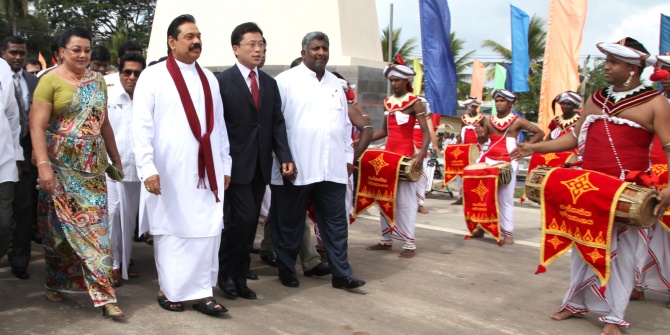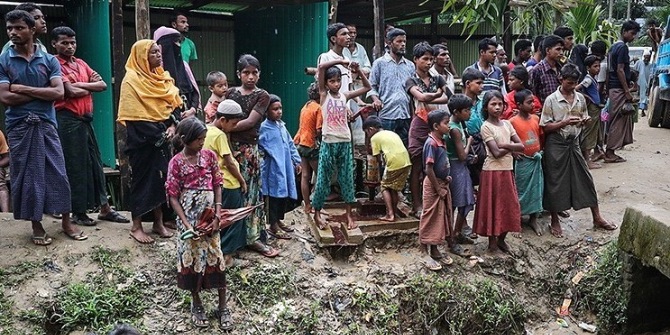 A quarter of Delhi residents are not served by the city’s water pipelines, making access to drinking water and sanitation facilities a major challenge. Matt Birkinshaw highlights innovative solutions developed to tackle the issue, but argues that ultimately more systematic reforms are needed to address water supply inequalities.
A quarter of Delhi residents are not served by the city’s water pipelines, making access to drinking water and sanitation facilities a major challenge. Matt Birkinshaw highlights innovative solutions developed to tackle the issue, but argues that ultimately more systematic reforms are needed to address water supply inequalities.
24.8% of Delhi’s population rely on water delivered in municipal tankers. New innovations in water supply methods from advocates, techies and social entrepreneurs promise to improve things, but changing mind-sets and inspiring political and community enthusiasm remain considerable challenges.
Last week I paid a visit to Savda Gevhra on the outskirts of Delhi. The area is a ‘sites and services’ resettlement colony. When slums across the city were demolished some of the people who could demonstrate that they met the conditions for resettlement were allocated plots here. Unfortunately, in most cases people were given little more than plots of land and continue to wait for adequate municipal services like water and sanitation.
Like other resettlement areas, in South Africa, for example, Savda Gevhra is at the city fringes some distance after Delhi’s scruffy low-rise urban sprawl has petered out. To get there we follow the raised concrete track of the Metro west from Karol Bagh, through streets peppered with ‘banquet halls’ and occasional luxury shops. Driving further out decreasing land values were reflected in the decreasing pretensions of the roadside eateries. The nearest metro-stop, Nangloi Jat, is busy, dusty and dominated by auto-repair businesses. From here, narrow roads lead through a semi-rural landscape of brown-grey fields and unfinished buildings.
Delhi’s water pipelines do not reach Savda Gevhra so municipal water tankers drive in water for residents. Delhi’s water authority, the Delhi Jal Board (DJB), operates a fleet of around 1,000 tankers but the service is often poor and unpredictable. In the past, there have been problems with DJB tankers loading up with water from unregulated filling stations, as well as private tankers loading from DJB stations. Tanker arrival is erratic. Children are often asked to watch out for the tanker because getting to it earlier means a better chance of getting a reasonable amount of water. Even then, the quantity supplied is limited; the DJB norm for per capita supply from tankers is 10 litres per person per day whereas the norm for piped supply is 150 litres per person per day. In low-income communities, fighting and jostling for tanker water can therefore be a problem. Operatives can also be ‘persuaded’ to stop closer to certain beneficiaries, allowing people to reach first and carry heavy buckets shorter distances.
In response to concerns, the DJB has recently introduced improvements to their tanker fleet. 400 new tankers have been fitted with GPS sensors and the drivers provided with smart cards. Under this system a schedule has been created with designated addresses and trip intervals. The smart cards enable operators to stock up the correct amount only from their nominated filling stations. Using GPS, tankers routes are tracked and recorded. The payment system is automated so that tankers which do not arrive do not get paid. Adherence to schedule is said to have increased and complaints from users gone down.
The data availability is good, but regulation is more complicated. Tankers are not owned by the DJB, and tanker staff are not DJB employees; any issues therefore have to be raised between the DJB and the tanker companies, rather than being dealt with more directly as might be possible if the DJB owned and managed the fleet. Some analysts suggest that tanker’s haphazard delivery has benefits for some and this would present a barrier to scaling up the model. Furthermore, the new tankers are seen as only serving areas where water was a prominent election issue.
Improvements to tanker service, while positive, still leave the basic inequality of water supply in Delhi unaddressed. Other initiatives have been set up in an attempt to provide alternatives to tanker supply. I was able to visit two of these decentralised approaches to the supply of potable water: micro-plants; and ‘water ATMs’.
The micro-water treatment plant at Savda has been set-up by an NGO, CURE. The plant is Tata technology and uses groundwater filtered through a membrane, carbon filter and then reverse osmosis. The plant is large, and not cheap. CURE was able to knock two houses together to make space for it. With his flat cap and heavy glasses the operator exudes a quiet authority. The business is a social enterprise and bottles are sold from the ground floor of the house at Rs5 a litre, or can be delivered for Rs7.

The ‘Water ATMs’ are a different model run by social enterprise Sarvojal, and there are five serving the same block. The round concrete pillars with embedded interface resemble a cross between a coffee-machine and (unsurprisingly) an ATM. They operate on a smart-card system and dispense water for Rs0.30 a litre. For context, the retail rate for commercially available bottled water Rs15-20 for one-litre bottles and Rs40-50 for 20 litre bottles. The average rate for government piped water is Rs0.15 per litre. The ATMs are connected to an online system through sim-cards and can be remotely monitored. In Savda, they are filled by a mini-tanker from a small water-treatment plant located in the block, however at other sites in Delhi they are filled with DJB water.
While some appreciate these alternative options, most of Savda Gedhra’s low-income residents still prefer the water provided by tankers despite poor and unpredictable service because it is free. Daily wage earners might earn just Rs100-150 per day and therefore cannot afford to spend on water. More systemic reforms are therefore still needed.
However, wider changes are underway in Delhi. At a national level, Modi’s BJP in power at the centre is speaking of ‘toilets before temples’ as part of the Swachh Bharat (‘Clean India’) campaign. The recent attention given to sanitation is welcome after decades of being overshadowed by attention to drinking water. In 2008 only 54% of population had access to basic sanitation, 21% shared facilities and 18% resorted to open defecation. While 98% of population is considered as having basic water access, the percentage with ‘improved access’ declined from 52% in 1990 to 48% in 2008. It is worth also noting that change is far slower at lower income levels (bottom quintile) and that aggregate statistics are skewed by fast movement in specific, more urbanised, states (Kerala, Tamil Nadu, Mahrashtra). Timing, reliability and quality of water supply is not measured by national indicators such as the National Sample Survey (NSS).
The Supreme Court has ruled that access to water and sanitation is covered under the Right to Life provisions in India’s Constitution. A National Water Act was first passed in 2002 (revised 2012) but more explicit norms for both urban water supply and groundwater use (now India’s largest water source) have yet to materialise. The Government of India’s 12th Five Year Plan (currently underway) explicitly states that unregularised areas should have no barrier to services. From a long-term perspective, service provision is economically preferable to the public health, productivity and education costs of service denial.
At a policy level the intention is therefore clear: all citizens of India should have piped water and sewerage, regardless of their settlement’s land-tenure status. With this in mind, decentralised on-site solutions provide a model which may present an alternative in remote areas or as interim measures during a delay while legal or financial issues are dealt with. However, equitable improvements to India’s urban water supply problems require systemic change and political determination.
About the Author
 Matt Birkinshaw is a researcher and PhD candidate at LSE’s Department of Geography and Environment. Visit his personal blog Saadaa Paanii or see here for more of his India at LSE contributions.
Matt Birkinshaw is a researcher and PhD candidate at LSE’s Department of Geography and Environment. Visit his personal blog Saadaa Paanii or see here for more of his India at LSE contributions.








1 Comments